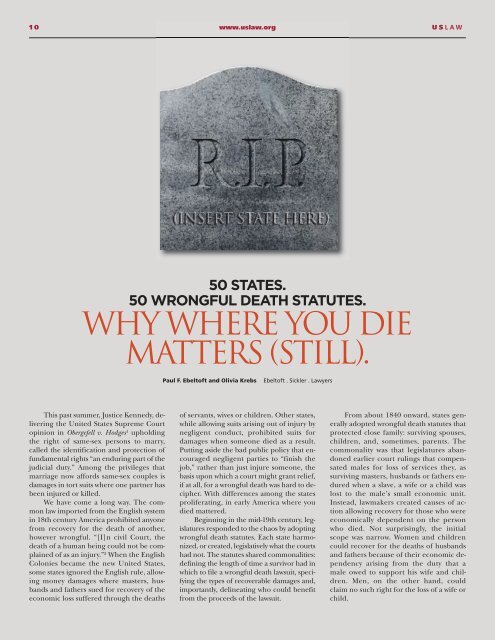CYBER BREACH FALLOUT
2015_Fall_Winter_USLAW-Magazine
2015_Fall_Winter_USLAW-Magazine
Create successful ePaper yourself
Turn your PDF publications into a flip-book with our unique Google optimized e-Paper software.
1 0 www.uslaw.org U S LAW<br />
(INSERT STATE HERE)<br />
50 STATES.<br />
50 WRONGFUL DEATH STATUTES.<br />
Why Where You Die<br />
Matters (Still).<br />
Paul F. Ebeltoft and Olivia Krebs<br />
Ebeltoft . Sickler . Lawyers<br />
This past summer, Justice Kennedy, delivering<br />
the United States Supreme Court<br />
opinion in Obergefell v. Hodges 1 upholding<br />
the right of same-sex persons to marry,<br />
called the identification and protection of<br />
fundamental rights “an enduring part of the<br />
judicial duty.” Among the privileges that<br />
marriage now affords same-sex couples is<br />
damages in tort suits where one partner has<br />
been injured or killed.<br />
We have come a long way. The common<br />
law imported from the English system<br />
in 18th century America prohibited anyone<br />
from recovery for the death of another,<br />
however wrongful. “[I]n civil Court, the<br />
death of a human being could not be complained<br />
of as an injury.” 2 When the English<br />
Colonies became the new United States,<br />
some states ignored the English rule, allowing<br />
money damages where masters, husbands<br />
and fathers sued for recovery of the<br />
economic loss suffered through the deaths<br />
of servants, wives or children. Other states,<br />
while allowing suits arising out of injury by<br />
negligent conduct, prohibited suits for<br />
damages when someone died as a result.<br />
Putting aside the bad public policy that encouraged<br />
negligent parties to “finish the<br />
job,” rather than just injure someone, the<br />
basis upon which a court might grant relief,<br />
if at all, for a wrongful death was hard to decipher.<br />
With differences among the states<br />
proliferating, in early America where you<br />
died mattered.<br />
Beginning in the mid-19th century, legislatures<br />
responded to the chaos by adopting<br />
wrongful death statutes. Each state harmonized,<br />
or created, legislatively what the courts<br />
had not. The statutes shared commonalities:<br />
defining the length of time a survivor had in<br />
which to file a wrongful death lawsuit, specifying<br />
the types of recoverable damages and,<br />
importantly, delineating who could benefit<br />
from the proceeds of the lawsuit.<br />
From about 1840 onward, states generally<br />
adopted wrongful death statutes that<br />
protected close family: surviving spouses,<br />
children, and, sometimes, parents. The<br />
commonality was that legislatures abandoned<br />
earlier court rulings that compensated<br />
males for loss of services they, as<br />
surviving masters, husbands or fathers endured<br />
when a slave, a wife or a child was<br />
lost to the male’s small economic unit.<br />
Instead, lawmakers created causes of action<br />
allowing recovery for those who were<br />
economically dependent on the person<br />
who died. Not surprisingly, the initial<br />
scope was narrow. Women and children<br />
could recover for the deaths of husbands<br />
and fathers because of their economic dependency<br />
arising from the duty that a<br />
male owed to support his wife and children.<br />
Men, on the other hand, could<br />
claim no such right for the loss of a wife or<br />
child.


